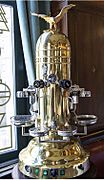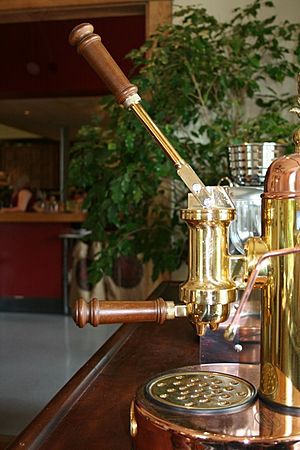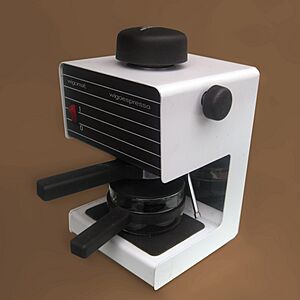Espresso machine facts for kids
An espresso machine is a special device that makes a strong, small cup of coffee called espresso. It works by pushing hot, pressurized water through finely ground coffee. This process creates a rich, concentrated coffee with a creamy foam on top, called crema. Espresso machines often have a steam wand too. This wand uses steam to heat and froth milk, which is perfect for making popular coffee drinks like cappuccino and caffe latte.
Espresso machines come in different types. Some use steam, others use a piston or a pump to push the water. There are also machines that use air pumps. You can find machines that are fully manual, where you do most of the work, or fully automatic, which do almost everything for you!
Contents
History of Espresso Machines
The idea for an espresso machine started a long time ago. In 1884, Angelo Moriondo from Turin, Italy, showed off one of the first machines. He even got a patent for his "New steam machinery for the economic and instantaneous confection of coffee beverage." Moriondo used his machines in his own coffee shops.
Later, in 1901, Luigi Bezzera from Milan made some important improvements to the machine. He was a mechanic, and his changes helped make the process better. In 1905, a person named Desiderio Pavoni bought Bezzera's patent. Pavoni then started the La Pavoni company and began selling these espresso machines. They made about one machine a day in a small workshop in Milan.
In 1933, Francesco Illy, who was Hungarian-Italian, invented a new kind of automatic coffee machine. His machine, called the Illetta, used pressurized water instead of steam. This was a big step and led to the modern espresso machines we see today.
How Espresso Machines Work
Many different types of machines have been made to create espresso. Even though they look different, many share similar parts and ways of working.
You can change the taste of espresso by how finely the coffee is ground. The amount of pressure used to pack the coffee grounds also makes a difference. Some baristas (people who make coffee) like to brew espresso directly into a warm cup. This helps keep the espresso hot and tasty.
Piston-driven Machines
The piston-driven, or lever-driven, machine was invented in Italy in 1945 by Achille Gaggia. He later started the Gaggia company. These machines have a lever that the person making coffee pulls down. This lever pushes hot water through the coffee grounds under pressure. Because you "pull" a long handle to make the espresso, people often say they are "pulling a shot." These machines are sometimes called manual espresso machines.
There are two main kinds of lever machines:
- Manual piston: You directly push the water through the coffee grounds.
- Spring piston: You pull the lever to tighten a spring. The spring then pushes the water through the coffee. This usually creates a pressure of about 8 to 10 bar (116 to 145 pounds per square inch).
Steam-driven Machines
Steam-driven machines use steam or steam pressure to push water through the coffee. The very first espresso machines used steam. They had a large boiler that sent steam to several brewing "group heads" at once. This allowed many cups of coffee to be made at the same time.
You can still find this design in some less expensive home machines today. They don't need many moving parts. However, steam-driven machines don't create as much pressure as pump-driven ones. This means the crema (the creamy foam on top of espresso) might not be as good.
Pump-driven Machines
Pump-driven machines are an improved version of the piston machine. They became very popular in commercial coffee shops after the Faema E61 machine was introduced in 1961. Instead of using a manual lever, an electric pump creates the pressure needed to brew espresso.
These machines can get water directly from a water pipe, which is common in busy coffee shops. Or, they can have a separate tank that you fill with water by hand. This is more common for home machines. Special electric pumps called "solenoid-piston" pumps are used because they can create high pressure and control the water flow very precisely.
For home machines, there are four main ways they heat water for brewing and steaming:
- Single boiler (SB): These machines only brew coffee and don't have a steam wand. They are not very common because steaming milk is a popular feature.
- Single boiler, dual use (SB/DU): These machines have one boiler that heats water for both brewing coffee and steaming milk. However, they can only do one task at a time. The brewing temperature is lower than the steaming temperature. So, the machine needs time to heat up or cool down when switching between making coffee and steaming milk.
- Heat exchanger (HX): These machines have one boiler that is kept hot enough for steaming. But, the water for brewing coffee passes through a special tube called a heat exchanger. This tube takes some heat from the steam, making the water warm enough for brewing, but not as hot as the steam. These machines often need a short "cooling flush" of water before you make the first espresso. This helps get the water to the perfect brewing temperature.
- Dual boiler (DB): These are usually found in higher-end machines. They have two separate boilers: one for brewing coffee and one for steaming milk. This means they can do both tasks at the same time and keep very stable temperatures. The first dual boiler machine was the La Marzocco GS in 1970.
Air-pump-driven Machines
In recent years, new espresso machines that use compressed air have appeared. These machines use air from a hand-pump, special gas cartridges, or an electric compressor to push hot water through the coffee. You usually add the hot water from a kettle or a thermos.
One great thing about air-pump-driven machines is that they are much smaller and lighter than electric machines. They are often handheld and easy to carry around. The Handpresso Wild, for example, was introduced in 2007 and is a popular portable option.
Espresso Machine Parts
A grouphead is the part of the machine where you attach the removable portafilter. Most home espresso machines have one grouphead. Larger professional machines, like those in coffee shops, can have many more. When you make espresso, hot water is pushed through the grouphead under pressure. The grouphead has many small holes, like a shower, to spread the water evenly over the coffee grounds.
A portafilter is a handle with a basket that holds the ground coffee. It attaches to the grouphead of the machine. Portafilters are usually made of brass to keep them warm, and they have a plastic or wooden handle. The portafilter creates a tight seal with the machine. This seal makes sure that the high-pressure hot water goes only through the coffee. Some baristas use "bottomless" portafilters. These let them see how the water is flowing through the coffee. This helps them check if the coffee is ground and packed correctly. After making a shot, baristas often use a knockbox to easily remove the used coffee grounds.
Automation in Espresso Machines
Machines that use pumps, sensors, valves, and grinders to do much of the brewing process automatically are called automatic machines.
- Semi-automatic: These machines use a pump to push water through the coffee, not manual force. You still need to grind the coffee and pack it yourself. You also decide when to stop the water flow.
- Automatic: These machines also control how much water flows through the coffee. They have a sensor that measures the water. Once the right amount of water has passed, the pump turns off automatically. You still need to grind and pack the coffee yourself.
- Super-automatic: These machines do almost everything! They automatically grind the coffee, pack it, and brew the espresso shot. You just need to fill the coffee bean container and empty the used grounds. Some even froth milk for you. While super-automatic machines are very convenient, they don't let you control the grinding and packing as much. This can sometimes affect the quality of the espresso.
Coffee shops often use semi-automatic machines with several group heads. These are much bigger than home machines and can make espresso shots very quickly. Many commercial machines can also work in an automatic mode.
Manual or semi-automatic machines give you more control over how your espresso tastes. Because you can decide exactly when to stop the brewing, many baristas prefer semi-automatic machines.
Stove Top Espresso Makers
Moka pots, also known as stove top espresso makers, are popular devices that make coffee using pressure. The coffee they make is similar to espresso in some ways. They are often called "espresso makers" because they use pressure and steam, just like the very first espresso machines.
Moka pots are similar to espresso machines because they brew under pressure and can create a creamy foam on top, like crema, depending on the coffee beans and how they are ground.
However, moka pots are different from modern espresso machines in a few ways:
- They brew under much lower pressure (about 1.5 bar or 21 psi) compared to modern espresso machines (about 9 bar or 130 psi).
- They use hotter water, a mix of boiling water and steam, which is above 100°C (212°F). Modern espresso machines use water between 92–96°C (198–205°F).
A moka pot has three parts:
- The bottom chamber holds the water.
- The middle chamber is a filter basket for the ground coffee. It sits inside the bottom chamber.
- The top chamber, with a metal filter, screws onto the bottom chamber.
When you heat the pot on a stove, steam pressure builds in the bottom chamber. This pressure forces the hot water up a tube, through the coffee grounds in the filter basket, and then into the top chamber. The coffee is then ready to serve! Moka pots are very common in countries like Italy, Spain, and Portugal. They are also sometimes called a macchinetta (Italian for "little machine") or caffettiera (Italian for "coffee maker").
he:מכונת אספרסו pl:Ekspres do kawy
See also
 In Spanish: Cafetera expreso para niños
In Spanish: Cafetera expreso para niños










